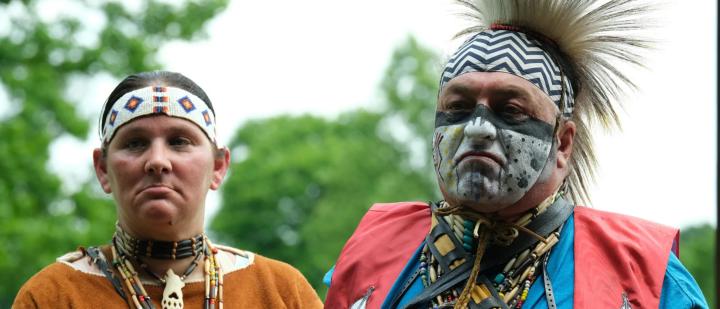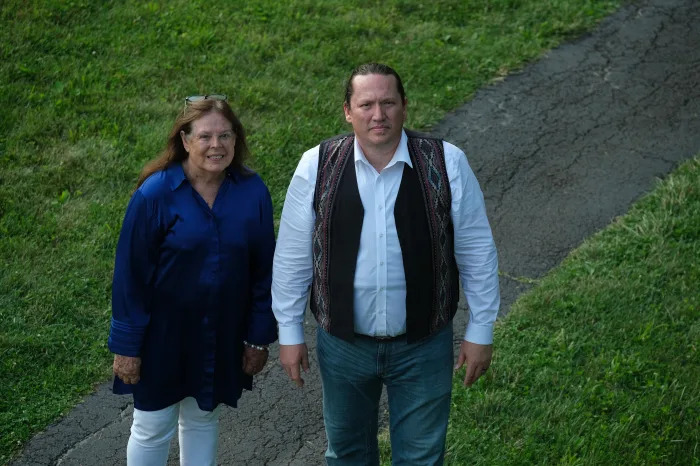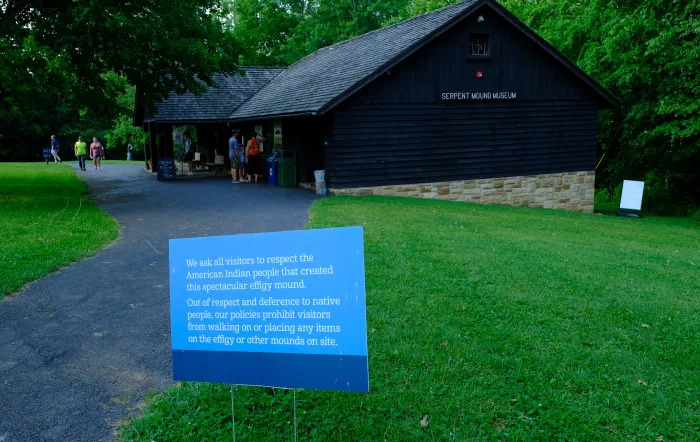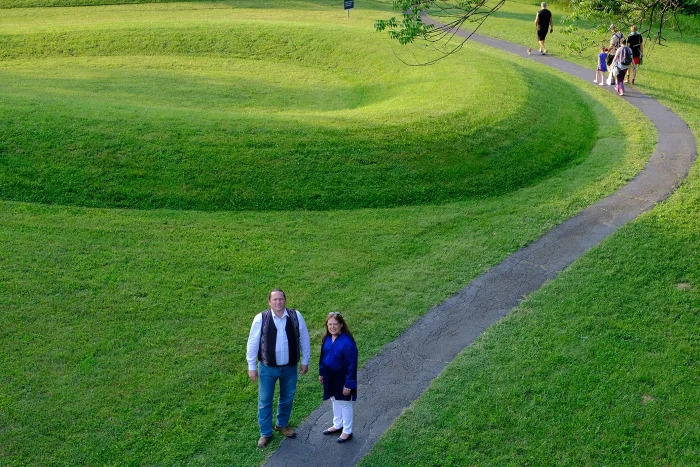 |
Canku Ota
|
 |
|
(Many Paths)
|
||
|
An Online Newsletter
Celebrating Native America
|
||
|
June 2021 - Volume 19
Number 6
|
||
|
|
||
|
Shawnee Reclaim The
Great Serpent Mound
|
||
|
by Mary Annette Pember
- Indian Country Today
|
||
|
Ancestors of
Native Americans, not prehistoric giants or space aliens, built
the mound in Ohio
The Shawnee tribe returned home to the Serpent Mound on the longest day of the year. The Summer Solstice, June 20, the longest day of the year, marks the first time that the Shawnee tribe has officially returned to the Serpent Mound located in Ohio to present their history and connection to this place that they called home so many years ago. Although it was certainly ancestors of the Shawnee people who built the magnificent serpent shaped mound, the largest earthwork effigy in the world, Ohio failed to involve the tribe in conveying its meaning to the public until now.
Glenna Wallace, chief of the Eastern Shawnee Tribe of Oklahoma and Ben Barnes, chief of the Shawnee Tribe, also located in Oklahoma, spent the weekend telling visitors to the Serpent Mound historical site about their peoples' and ancestors' connection to Ohio and the mound. Although the weekend was hot and muggy, visitors crowded quietly under a covered shelter to hear the chiefs talk of their tribes’ histories and connections to this remarkable place. Wallace described the devastating impact of federal assimilationist policies such as removal on her tribe. “The government’s assimilationist policies were almost a successful genocide for my people. By 1900, our numbers were reduced to 69 people,” she said. According to Wallace, many Shawnee people lost their language, culture and ceremonies. Both Wallace and Barnes, however, described their peoples’ deep connection to Ohio, the Serpent Mound and the surrounding series of earthworks in the region. Their overwhelming message is one of reverence and respect for the sacred and a plea for visitors to appreciate and honor the Serpent Mound as they would a cathedral, synagogue or mosque. In recent years, activities at the mound have taken on the quality of what Barnes describes as a minstrel show disrespecting and appropriating Native cultures.
Since the 1987 Harmonic Convergence, the mound has become a mecca for followers of New Age spirituality. The idea of the Convergence was created by author and art historian Jose Arguelles who claimed August 16-17, 1987, were significant dates in the Maya calendar and represented an especially auspicious time to meditate for global peace. Some New Age activities such as digging and burying items in the mound, forwarding information purporting that the effigy was built by aliens from space or prehistoric giants and misrepresenting Native connections to the site has been of growing concern to tribal leaders like Wallace and Barnes. Of even greater concern was the way that past managers of the Serpent Mound site often turned a blind eye to these activities, sometimes allowing such practitioners to manage and stage events at the mound. This sent a message to the public that these wild theories were part of the official history of the site according to Wallace and Barnes. Wallace reached out to the Ohio History Connection a few years ago, sharing her concerns. After several years of meetings and negotiations with leaders at the History Connection, they soon realized that it was imperative to involve the Indigenous people who once called the state home in creating the story of ancient places such as the Serpent Mound. In March 2021, the Ohio History Connection took over direct supervision of the Serpent Mound after having subcontracted its management to a private organization for several years. “It's important for people who come to visit this site to understand who occupied this land, who built the serpent and to be really clear that it was built by American Indian people,” said Megan Wood, director of cultural resources at the Ohio History Connection. “So we started working together with the tribes to make sure that during this solstice and hopefully future solstice and equinox events that there be tribal members here to talk about what this site means to them and help communicate to visitors how to respect the mound, not to walk on it, to treat it like you would an historic church,” Wood added. For many non-Natives in Ohio, Native Americans are part of a distant, ancient past. In 1830, the Shawnee and other tribes were removed from Ohio by the federal Dawes or Indian Removal Act. The Shawnee eventually settled in Oklahoma; there are no federally recognized tribes located in Ohio. The current Native American population in the state is around .3 percent. This lack of Native presence may have helped fuel the proliferation of unusual stories and legends, according to Wood. “In Ohio, people know very little about Native American history. When we’re able to talk about the federal government’s removal policies and what happened here, how long Native peoples were in Ohio and the fact that they are still living vibrant communities is very interesting to visitors,” Wood said.
According to an article written by Barnes and Brad Lepper, curator of Archaeology and manager of Archaeology and Natural History at the Ohio History Connection, “Archaeologists agree that ancestors of American Indians built the mound but disagree about which ancestors. We think the available evidence supports a Late Pre Contact period age of around AD 1100, whereas some other archaeologists think it was built at around 300 BC during the Early Woodland period.” Ohio is home to many earthworks and mounds including the Newark Earthworks, the largest set of geometric earthen enclosures in the world. Archaeologists say the Newark Earthworks were built between 100 B.C. and 500 A.D. by the Hopewell culture. Like the earthworks built by the Hopewell, the Serpent Mound may have a cosmic connection. The head and oval are aligned to the setting sun on the summer solstice. The mound is a National Historic Landmark; in 2008 the Serpent Mound and eight other Ohio earthworks were selected for inclusion on the U.S. tentative list of sites to be submitted to the United Nations Educational, Scientific and Cultural Organization, (UNESCO) World Heritage list. “The great serpent is present within our Shawnee traditions and religious practices today; this is our umbilical, our connection to the world below,” Barnes told the crowd. “I realized that the only way to help my people understand this place was to abandon words, to get them in a van and travel here. Now they understand why it needs to be protected,” he said. The sounds of drums and flutes could be heard in the distance as Barnes spoke. Another summer solstice event was taking place. Vendors, speakers and performers who previously occupied the summer solstice event at the Serpent Mound relocated to a space next door, at Soaring Eagle Retreat. Here, visitors could still learn about prehistoric giants and ancient aliens' roles in building the mounds. People from various unrecognized tribes performed dances and offered drum and crystal workshops. One couple dressed in Native inspired dance regalia walked from the Soaring Eagle Retreat to the shelter where Wallace and Barnes were conducting their presentation and tried to interrupt. Barnes gently asked them to wait until Chief Wallace finished speaking. “He was very rude; he wouldn’t take my tobacco,” Tommy Blue Dancer and his companion Shelly Wolf Mother told Indian Country Today. Both claimed to be citizens of the Chickamauga Cherokee tribe of Kentucky, a state with no federally recognized tribes. Indian Country Today was unable to find any information about the Chickamauga Cherokee tribe of Kentucky. According to the National Conference of State Legislatures, Kentucky does not have a process in which tribes can be recognized by the state. Blue Dancer and Wolf Mother left without incident. Several people from Soaring Eagle Retreat walked around the path surrounding the mound, some dressed in what appeared to be historic reenactment costumes or Native inspired garb. Overall, everyone was respectful, staying off the mound and quietly enjoying the space. “People want to be on the mound and be close to it; there are ideas around crystals and energies. Anyone can come here and think and feel what they want but can’t physically interact with the effigy mound. We are trying to have more staff here and also inviting tribal partners to help people understand why those things aren’t appropriate,” said Wood.
“Unfortunately the Serpent Mound has become the epicenter of efforts to appropriate sacred American Indian sites and replace the Indigenous story with all sorts of fantastic, absurd stories,” said during his solstice presentation. “Let’s be absolutely clear. At the heart of these myths and fantastic stories is the racist notion that American Indians were too stupid to have built something so wonderful,” he added. Barnes agreed. “Native people have inherent rights as defined by the U.N. Declaration on the Rights of Indigenous Peoples; that includes free prior and informed consent on how we are portrayed,” he said. After three long, hot days of multiple public presentations, Barnes, Wallace and citizens of both Shawnee tribes feasted and prayed. At sunset they walked to the head of the great serpent, gazing out towards the horizon. As the sun dipped into darkness, a moment of connection was palatable, the Shawnee had come home.
Mary Annette Pember, a citizen of the Red Cliff Ojibwe tribe, is a national correspondent for Indian Country Today. |
||||||||||
|
|
|
|
||
|
|
||
| Canku Ota is a free Newsletter celebrating Native America, its traditions and accomplishments . We do not provide subscriber or visitor names to anyone. Some articles presented in Canku Ota may contain copyright material. We have received appropriate permissions for republishing any articles. Material appearing here is distributed without profit or monetary gain to those who have expressed an interest. This is in accordance with Title 17 U.S.C. Section 107. | ||
|
Canku Ota is a copyright ©
2000 - 2021 of Vicki Williams Barry and Paul Barry.
|
||
 |
 |
|
|
The "Canku
Ota - A Newsletter Celebrating Native America" web site and
its design is the
|
||
|
Copyright ©
1999 - 2021 of Paul C. Barry.
|
||
|
All Rights Reserved.
|
||




